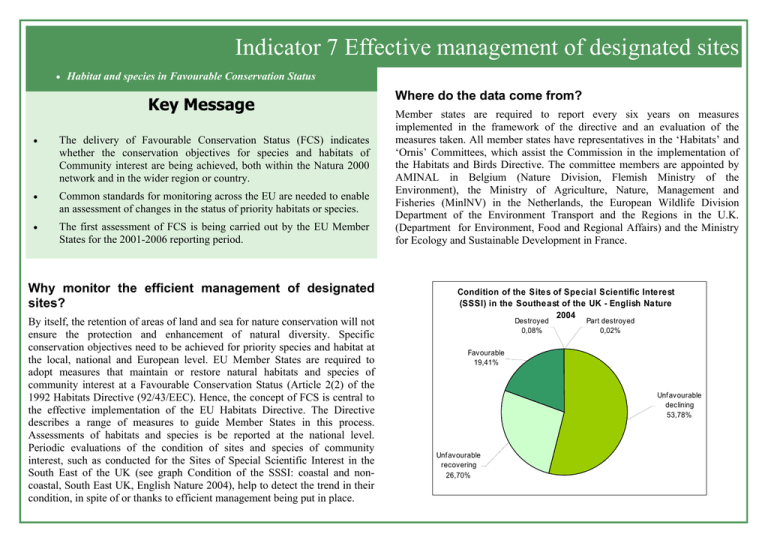Indicator 7 Effective management of designated sites Key Message
advertisement

Indicator 7 Effective management of designated sites • Habitat and species in Favourable Conservation Status Key Message • The delivery of Favourable Conservation Status (FCS) indicates whether the conservation objectives for species and habitats of Community interest are being achieved, both within the Natura 2000 network and in the wider region or country. • Common standards for monitoring across the EU are needed to enable an assessment of changes in the status of priority habitats or species. • The first assessment of FCS is being carried out by the EU Member States for the 2001-2006 reporting period. Why monitor the efficient management of designated sites? By itself, the retention of areas of land and sea for nature conservation will not ensure the protection and enhancement of natural diversity. Specific conservation objectives need to be achieved for priority species and habitat at the local, national and European level. EU Member States are required to adopt measures that maintain or restore natural habitats and species of community interest at a Favourable Conservation Status (Article 2(2) of the 1992 Habitats Directive (92/43/EEC). Hence, the concept of FCS is central to the effective implementation of the EU Habitats Directive. The Directive describes a range of measures to guide Member States in this process. Assessments of habitats and species is be reported at the national level. Periodic evaluations of the condition of sites and species of community interest, such as conducted for the Sites of Special Scientific Interest in the South East of the UK (see graph Condition of the SSSI: coastal and noncoastal, South East UK, English Nature 2004), help to detect the trend in their condition, in spite of or thanks to efficient management being put in place. Where do the data come from? Member states are required to report every six years on measures implemented in the framework of the directive and an evaluation of the measures taken. All member states have representatives in the ‘Habitats’ and ‘Ornis’ Committees, which assist the Commission in the implementation of the Habitats and Birds Directive. The committee members are appointed by AMINAL in Belgium (Nature Division, Flemish Ministry of the Environment), the Ministry of Agriculture, Nature, Management and Fisheries (MinlNV) in the Netherlands, the European Wildlife Division Department of the Environment Transport and the Regions in the U.K. (Department for Environment, Food and Regional Affairs) and the Ministry for Ecology and Sustainable Development in France. Condition of the Sites of Special Scientific Interest (SSSI) in the Southeast of the UK - English Nature 2004 Destroyed 0,08% Part destroyed 0,02% Favourable 19,41% Unf avourable declining 53,78% Unf avourable recovering 26,70% Effective management of designated sites What does the indicator show? So far, no assessments have been reported to the European Commission. The reporting authorities of the countries in the Southern North Sea will deliver a first assessment for the Habitats Directive by 2007 (reporting period 2001-2006). Conservation measures for the delivery of the objectives of the Birds Directive were evaluated in 2005. In order to evaluate habitat as at Favourable Conservation Status, Member States have to ensure that the habitat’s typical species are at FCS. Typical species are interpreted as more than just the species listed in the Annexes to the Directive. They also include all those species that are characteristic of a habitat. To achieve this, Member States have to gather the necessary and up to date scientific data on population dynamics and varying ecological requirements. Assessments will make reference to European, national and local status of all populations throughout their natural range and genetic variation. Evaluations will be reported as the result of a matrix of scores and ranked as ‘favourable’, ‘unfavourable-inadequate’ and ‘unfavourablebad’. With the exception of marine protected areas, all sites in the UK designated to conserve internationally important wildlife, are based on pre-existing Sites of Special Scientific Interest (SSSI). This means that all sites designated under the Ramsar Convention and the Birds and Habitats directives will also be a SSSI. The South East England Biodiversity Forum target is for all SSSI to be in favourable condition by 2010. An evaluation of the degree of achievement of specific conservation objectives of the SSSI in the South East was carried out in 2004. ©MDK How reliable is the indicator? What are the implications for planning and managing the coast? The Habitats and Birds Directives offer a legal basis for common standards and objectives for nature conservation at the EU level. Member states have translated this legal framework into their national legislation and have set targets for the conservation of priority habitats and species. These targets are known as “Favourable Conservation Status”. The legal provisions of the Habitats and Birds Directives are so stringent that Member States will need to integrate ensuring the delivery of favourable conservation status into sectoral policies. The common criteria for monitoring, evaluation and reporting will set standards for all Member States in measuring the effectiveness of management and conservation of species and habitats of community interest. The Birds and Habitats Directives are harnessed with legal provisions for close surveillance of Member States commitments. Considerable financial sanctions are issued to countries that do not deliver according to these standards. An accurate assessment of changes in species and habitats will depend on the ability of the Committees to draw common standards of monitoring across the EU. The definition of ‘Favourable Conservation Status’ needs to be unambiguous and allow for a clear interpretation or a recommendation on how to implement it. Finally, reliability will depend on rigorous data collection processes being put in place.







